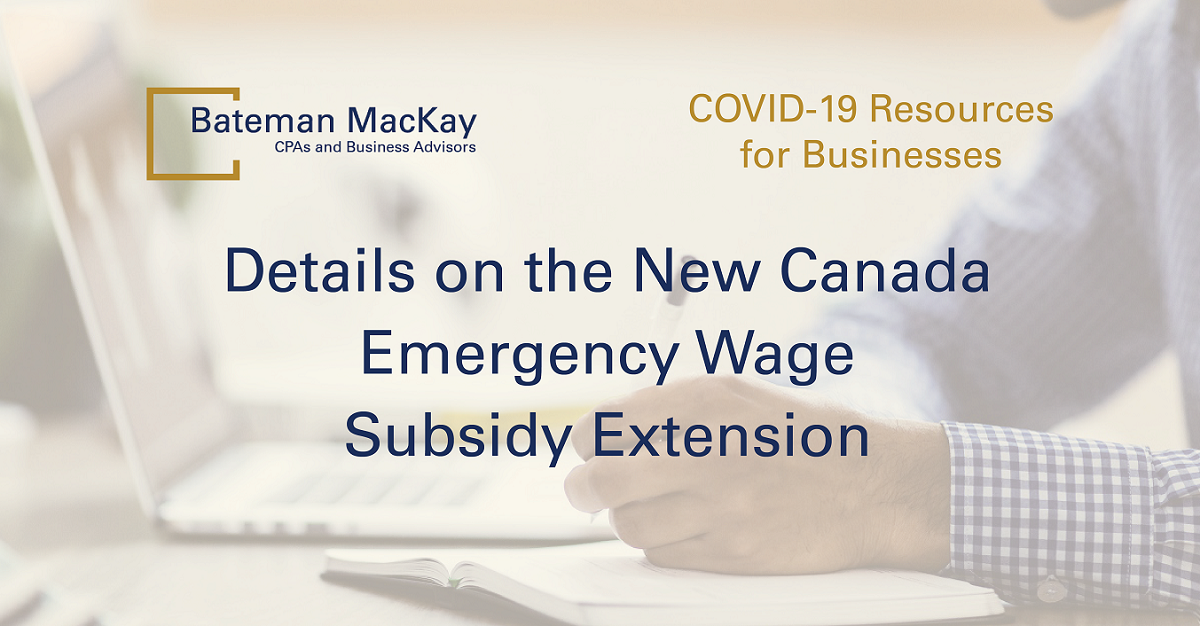
Since the first Temporary Wage Subsidy, (TWS) announced in early March, the Federal Government’s wage subsidy programs have continued to evolve over the course of the pandemic. Following the TWS, the Canada Emergency Wage Subsidy (CEWS) was implemented, extended, reinvented and extended again, each time providing changes as to how they may benefit businesses. Details on how the operation of the CEWS recent extension have been revealed. These details and include special additions for furloughed employees, employees returning from leave and asset purchases.
CEWS Extension Details
What – A subsidy from the Federal Government which covers a portion of employee’s wages.
Who - available to any individual, corporation (or trust), registered charities, partnerships consisting of eligible employers and other certain organizations which had a payroll account on March 15, 2020, and have experienced a drop in revenue.
When – Running from March 15, 2020, to June 2021 (proposed). The current regulations and subsidy rates apply for periods 8 (September 27-October 24), 9 (October 25-November 21) and 10 (November 22-December 19). Application deadlines are the later of January 31, 2021, or 180 days after the end of the qualifying period.
Where – Business owners apply online on the Canada Revenue Agency (CRA) website.
How – The base wage subsidy is determined by the change in an eligible employer’s monthly revenues, year-over-year, or comparing to an average of January and February 2020, for either the current or previous calendar month (i.e. For Period 8 any of: October 2020 to October 2019, September 2020 to September 2019, October 2020 to an average of January and February 2020, September 2020 to an average of January and February 2020). If an employer has a 50% or greater revenue decline, they are entitled to a 40% wage subsidy to a maximum weekly benefit per employee of $452. If an employer has a 0% to 49% revenue decline, they are entitled to 0.8 X their revenue decline up to a maximum weekly benefit per employee of $452 (i.e. 20% revenue drop * 0.8 = 16% subsidy rate).
Top-up Wage Subsidy
A top-up subsidy up to an additional 25% is available to any employer who is eligible for the CEWS and has a minimum 70% revenue loss in a single period. This criteria represents a change from the previous comparison method for the top-up wage subsidy which used the preceding three months’ revenue decline (i.e. An employer who saw a 70% revenue decline when comparing October 2020’s to October 2019’s revenues would be eligible for a 65% wage subsidy comprised of a 40% base subsidy and a 25% top-up subsidy).
Safe Harbour Rule
For Periods 8 through 10 (September 27-December 19), an eligible employer would be entitled to a top-up subsidy rate not lower than the rate that it would receive if its revenue loss was calculated under the previous three months revenue decline test (i.e. an employer who had a revenue decline of 55% when comparing October 2020 to October 2019 and a revenue decline of 65% when comparing July - September 2020 over July – September 2019 would use the 65% decline for their top-up subsidy calculations).
Furloughed Employees
For Periods 9 (October 25 – November 21) and 10 (November 22 – December 19), the wage subsidy for furloughed employees would be adjusted to align with the benefits provided through Employment Insurance (EI). The wage subsidy for a furloughed employee would be the lesser of:
For example, if a furloughed employee’s pre-crisis weekly remuneration was $1,050, they would receive the maximum subsidy amount of $573)
The government shall continue to refund the employer portion of contributions in respect of the Canada Pension Plan, Employment Insurance, the Quebec Pension Plan and the Quebec Parental Insurance Plan for furloughed employees.
Employees Returning from Leave
A special baseline remuneration period has been created for an eligible employee returning from a continuous maternity, parental, caregiver or long-term sick leave that began before July 1, 2019, and ended after March 15, 2020. The special period is the 90-day period ending immediately before the beginning of the employee’s leave period.
Asset Purchases
When an entity purchases all or substantially all of the business assets of a seller and the purchaser and seller jointly elect, the purchaser can use the prior reference period revenues associated with those assets for the purpose of computing its revenue decline. This rule is expanded to allow it to be used when an entity purchases the assets of a business, or of a distinct part of a business, from an arm’s length seller and the purchaser uses those assets to carry on a business if the purchaser and seller make a joint election.
As with previous CEWS expansions, these rules can be very complex and require a complete understanding of the regulations and accurate calculations to maximize the benefit. If you have questions about CEWS or any other COVID-19 support program, please reach out to your Bateman Mackay Business Advisor.
Sign up for our newsletter and receive tax, accounting, and business advisory resources for your business!